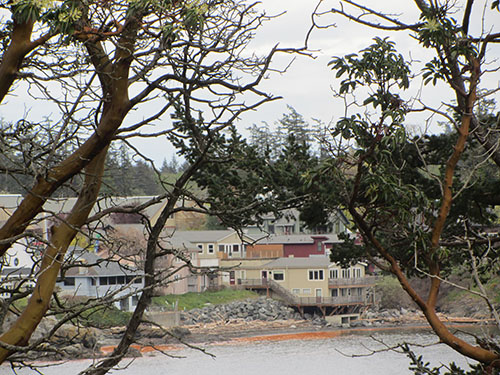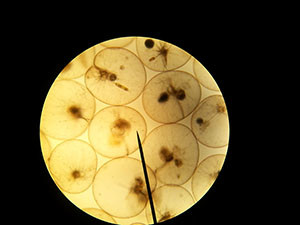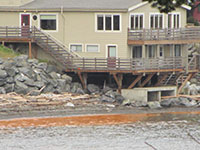— by Lin McNulty —

Staff photo.
It’s too early in the season for the San Juan County Health Department to be conducting their routine monitoring. So that rusty red tinge we see on the shoreline, may or may not be a toxic algae bloom.
Kyle Dodd, Environmental Health Manager for the County says that although there is currently no information on this algae bloom, it is always best to assume it may be harmful.
A red tide is caused by algal blooms which become so numerous that they discolor coastal waters. The algal bloom may also deplete oxygen in the waters and/or release toxins that may cause illness in humans and other animals.
Our first sighting last year was on April 12, a week later than this event. For additional information, see last year’s story.
UPDATE FROM RUSSEL BARSH, KWIAHT:
That orange color in the water along some East Sound shorelines is an unusually early-season algal bloom, but it is not toxic. The culprit is Noctiluca scintillans, a tiny scavenger that looks like a round clear plastic bag under the microscope. It is also responsible for “sea sparkle” on calm summer nights. Noctiluca is a dinoflagellate, a group of very fast-reproducing organisms that share some of the characteristics of animals and plants. Most of them can photosynthesize, but they also engulf and consume other plankton. They move quickly between the sunlit surface of the sea and darker depths by the motion of a whip-like “tail”, the flagellum. And while some dinoflagellates exude toxic chemical compounds in self-defense, which clams and other shellfish can concentrate making them dangerous to human consumers, Noctiluca is not one of them. It just looks scary.

Micro photograph of a sample of bloom courtesy of Lynette Wood, Orcas Island Phytoplankton Survey Team.
Noctiluca contain small quantities of chlorophyll a, but the “tomato soup” color of a Noctiluca bloom appears to be due to other pigments that this organism uses as a kind of sunscreen, similar to the purple anthocyanins of many garden vegetables.
Larger, more frequent, more year-round algal blooms (toxic as well as non-toxic) are a symptom of warming oceans. They are also most likely to form in warm, shallow bays, especially near sources of extra nitrogen and phosphorus from gardens or farms.
Islanders interested in algal blooms can help Kwiaht, the Indian Island Marine Health Observatory, and the Orcas Island Phytoplankton Survey Team (SoundToxins) to locate, sample, and identify them. Follow the phytoplankton team on Facebook, or send an email to kwiaht@gmail.com to get involved!
**If you are reading theOrcasonian for free, thank your fellow islanders. If you would like to support theOrcasonian CLICK HERE to set your modestly-priced, voluntary subscription. Otherwise, no worries; we’re happy to share with you.**









Saw same yesterday (Monday) at east end of Crescent Beach.
The “tomato soup” colored blooms are caused by non-toxic Noctiluca. The Orcas Island Phytoplankton survey team (which works with the Indian Island Marine Health Observatory and Kwiaht) has sampled this bloom and confirmed that it is made up primarily of Noctiluca. Better known as “sea-sparkle” for the phosphorescence it causes at night, Noctiluca blooms are common when the weather warms up, particularly when rains bring nutrients to marine waters as runoff. More info can be found on the Indian Island Marine Health Observatory Facebook Page https://www.facebook.com/Indian-Island-Marine-Health-Observatory-123487341016301
Thanks to Russel and Madrona for keeping us informed and being the chief stewards of our environment.
hmmm… with a big condo development proposed up-slope to the North, from both the Bay at Crescent Beach and the Land Bank preserve (which has the freshwater stream draining out to Crescent Beach), much of the remaining forest at the site of the proposed development is slated to be cut down. I am hoping that the sewage and all else that will run downhill to the south and east from the proposed development will not affect the Land Bank preserve and the bay, further adding nitrates, hormone disruptor, silt intrusion, and the like.
What is the status of that permit? What are the plans the County has to protect the waters from these impacts, not to mention erosion and storm water runoff? Is there an EIS study, and will the people have a chance to comment? Will further studies be done as to suitability of the project and site? How will these changes affect algae bloom, both toxic and non toxic? Will the loss of the woods (and windbreak), tree roots filtering runoff, and biodiversity, what kinds of impacts to the bay at Crescent Beach and the waters flowing into them can we expect?